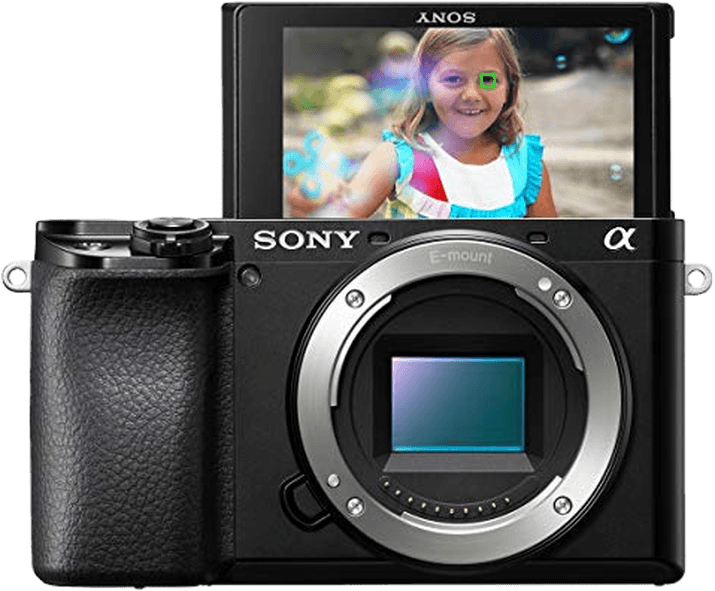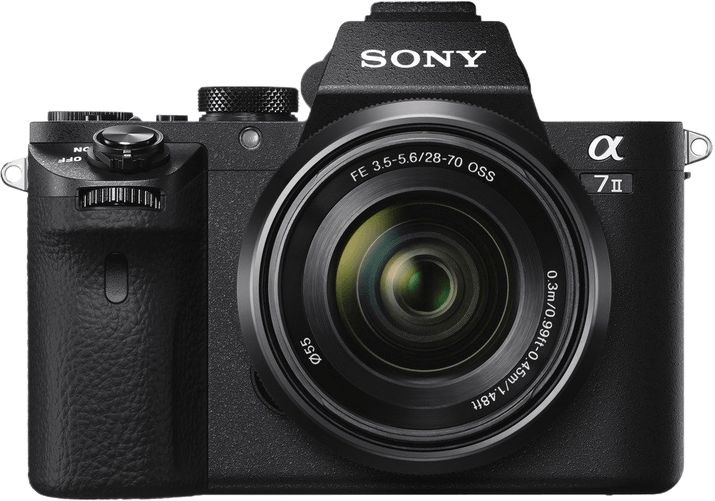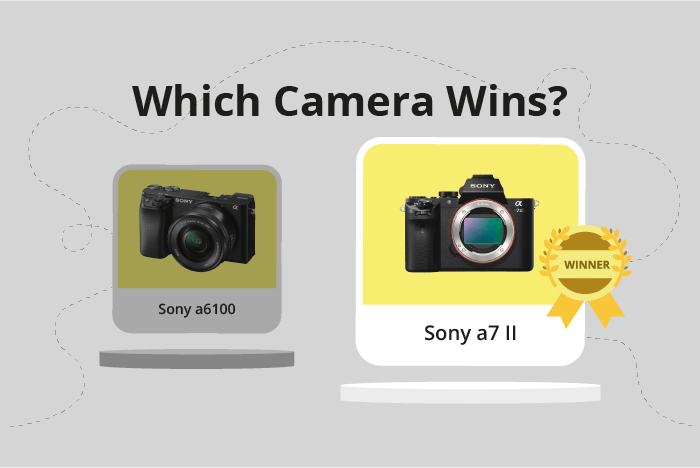Sony a6100 vs a7 II Comparison
Sony a6100

Sony a7 II

The Sony a7 II edges out the Sony a6100 with a score of 68/100 compared to 66/100. Both cameras are mirrorless and share similar specifications. The a6100, released in 2019, is newer and more affordable at $750, while the a7 II, released in 2014, has a launch price of $1600.
The Sony a6100 excels with its compact size, measuring 120 x 67 x 59mm and weighing only 396g. This makes it ideal for photographers seeking a lightweight option. In contrast, the Sony a7 II is larger at 127 x 96 x 60mm and heavier at 599g.
Despite its age and higher price, the Sony a7 II earns a slightly higher score due to its superior performance and features. Both cameras offer unique benefits, with the a6100 being more budget-friendly and portable, while the a7 II provides a more robust feature set for advanced photographers.
Sony a6100 vs a7 II Overview and Optics
The Sony a7 II triumphs over the Sony a6100 in optics with a score of 78/100 compared to the a6100’s 68/100. Both cameras share several specifications, including a 24-megapixel CMOS sensor, Bionz X processor, and Sony E lens mount. Despite these similarities, the winning camera, the Sony a7 II, excels in specific areas.
The Sony a7 II’s superior optics performance is due to its full-frame sensor size, which allows for better low-light performance and increased dynamic range. Additionally, the a7 II has a higher DXOMARK sensor score of 90 compared to the a6100’s 82. Another significant advantage of the Sony a7 II is its built-in image stabilization, which helps achieve sharper images when shooting handheld or in low light conditions.
On the other hand, the Sony a6100 offers a faster shooting speed of 11 frames per second compared to the a7 II’s 5 frames per second. This attribute makes the a6100 more suitable for capturing fast-moving subjects, such as sports or wildlife photography.
Taking these factors into account, the Sony a7 II stands out as the better camera for optics due to its full-frame sensor, higher DXOMARK score, and image stabilization. This camera is ideal for those who prioritize image quality and low light performance. The Sony a6100, with its faster shooting speed, is a better option for photographers who require quick capture capabilities.
Sony a6100 vs a7 II Video Performance
The Sony a6100 outperforms the Sony a7 II in terms of video capabilities, scoring 91/100 compared to the a7 II’s 56/100. Both cameras share some common features, such as autofocus and exposure control during video recording. However, the a6100 has several advantages that help it achieve a higher score.
One significant advantage of the a6100 is its 4K video resolution, with maximum dimensions of 3840 x 2160. This is considerably higher than the a7 II’s Full HD resolution of 1920 x 1080. As a result, the a6100 can capture more detailed and sharper videos, making it a better choice for videographers.
Another aspect that sets the a6100 apart is its maximum video frame rate of 120fps, which is double the a7 II’s 60fps. This higher frame rate allows for smoother slow-motion footage, providing more creative options for video creators. Additionally, the a6100 has built-in time-lapse functionality, which the a7 II lacks. This feature enables users to capture stunning time-lapse sequences without the need for additional equipment or software.
Despite the lower score, the Sony a7 II still has some advantages in video capabilities. Its full-frame sensor provides better low-light performance and a shallower depth of field when compared to the a6100’s APS-C sensor. This can result in more cinematic-looking footage with better background separation.
Taking all factors into account, the Sony a6100 is the superior choice for video capabilities, offering 4K resolution, a higher frame rate, and built-in time-lapse functionality. However, the Sony a7 II still holds its ground in low-light performance and depth of field, making it a viable option for those who prioritize these aspects.
Sony a6100 vs a7 II Features and Benefits
The Sony a6100 triumphs over the Sony a7 II in features, boasting a score of 68/100 compared to the a7 II’s 57/100. Both cameras share some common specifications, such as a 3-inch screen size, flip screen, lack of GPS, and WIFI capabilities. However, the a6100 outperforms the a7 II in certain areas, while the a7 II has a few advantages of its own.
One of the a6100’s superior features is its touchscreen, which the a7 II lacks. This allows for quicker and more intuitive navigation and control. Additionally, the a6100 has Bluetooth connectivity, offering more convenience and compatibility with other devices. These features contribute to the a6100’s higher score.
On the other hand, the a7 II has a higher screen resolution at 1,230,000 dots, compared to the a6100’s 921,600 dots. This results in a clearer and sharper display, which is beneficial for reviewing images and videos.
Despite the a7 II’s advantage in screen resolution, the a6100’s touchscreen and Bluetooth capabilities ultimately make it the better camera in terms of features. Its higher score reflects its superiority in this aspect. The a7 II’s higher screen resolution is not enough to outweigh the a6100’s additional features, resulting in its lower score. When considering a camera with a focus on features, the Sony a6100 is the clear choice.
Sony a6100 vs a7 II Storage and Battery
The Sony a6100 outperforms the Sony a7 II in storage and battery with a score of 37/100 compared to the latter’s 21/100. Both cameras share similarities, including one memory card slot and compatibility with SD/SDHC/SDXC and Memory Stick Pro Duo cards. They also use the same NP-FW50 battery type.
The a6100’s superiority stems from its longer battery life, providing 420 shots compared to the a7 II’s 350 shots. Additionally, the a6100 supports USB charging, making it more convenient for on-the-go users.
The a7 II has no significant advantages in storage and battery, but it does accept Memory Stick Duo/Pro Duo/Pro-HG Duo cards, offering slightly more versatility in memory card options.
Considering these factors, the Sony a6100 is the better choice for users who prioritize extended battery life and convenient charging options.
Sony a6100 vs a7 II – Our Verdict
Are you still undecided about which camera is right for you? Have a look at these popular comparisons that feature the Sony a6100 or the Sony a7 II:

